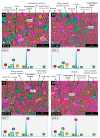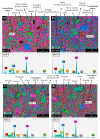Valorisation of "La Palma" Volcanic Ash for Making Portland-Blended, Alkaline and Hybrid Portland-Alkaline Cements
- PMID: 38204095
- PMCID: PMC10779707
- DOI: 10.3390/ma17010242
Valorisation of "La Palma" Volcanic Ash for Making Portland-Blended, Alkaline and Hybrid Portland-Alkaline Cements
Abstract
The present work evaluates the feasibility of using volcanic fly ash (VFA) generated by the eruption of the Tajogaite volcano on the island of La Palma (Spain) in 2021, as a precursor in the preparation of cementitious materials with different Portland cement (PC) replacement levels (0%, 30%, 70% and 100%), in the absence (Blended Cement, BC) and presence of an alkaline activator (Hybrid Alkaline Cement, HAC, and Alkaline Cements, AC). Hydration kinetics (isothermal conduction calorimetry), paste mechanical strengths and reaction products were characterised by XRD, FTIR, TG/DTG and BSEM/EDX. The results obtained indicate that the strengths developed by the hybrid alkaline cements (HAC) are higher than those of the blended cements (BC), especially at the age of 2 days, where 25 MPa were obtained with the replacement of 70% PC by VFA. Alkaline cements (AC, 100% VFA) that were prepared with 8 M NaOH solution as the activator reached 40 MPa after 2 days. It was observed that in all the binders, depending on the initial composition of the binder mixture and the percentage of replacement and/or activator, VFA reacts to form cementitious gels, C-A-S-H and N-A-S-H type, which supports its use as a mineral addition to blended cement or as a precursor in the preparation of alkaline and hybrid alkaline cements.
Keywords: alkaline cement; blended cement; hybrid alkaline cement; volcanic fly ash.
Conflict of interest statement
The authors declare no conflicts of interest.
Figures












References
-
- Gobierno de Canarias, Informe Comite Científico, Islas Canarias, 2021. [(accessed on 9 September 2023)]. Available online: https://www3.gobiernodecanarias.org/noticias/la-erupcion-de-la-palma-se-...
-
- Tashima M.M., Soriano L., Borrachero M.V., Monzó J., Payá J. Towards the valorization of Cumbre Vieja volcanic ash–Production of alternative cements. Constr. Build. Mater. 2023;370:130635. doi: 10.1016/j.conbuildmat.2023.130635. - DOI
-
- Olawuyi B.J., Olusola K.O. Compressive Strength of Volcanic Ash/Ordinary Portland Cement Laterized Concrete. Civ. Eng. Dimens. 2013;12:23–28. doi: 10.9744/ced.12.1.23-28. - DOI
-
- Siddique R. Properties of concrete made with volcanic ash. Resour. Conserv. Recycl. 2012;66:40–44. doi: 10.1016/j.resconrec.2012.06.010. - DOI
LinkOut - more resources
Full Text Sources
Medical
Research Materials
Miscellaneous

